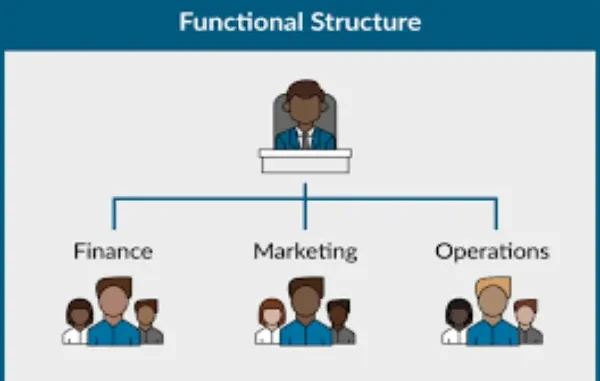
A functional business structure is one of the most widely adopted organizational frameworks used by companies worldwide. This structure groups employees based on specialized roles or functions, creating a clear hierarchy and efficient workflow. By organizing teams around specific business functions, companies can improve operational efficiency, communication, and overall performance.
In this article, we will explore the ins and outs of a functional business structure, its advantages, challenges, and how it can benefit different types of organizations. Whether you’re a small business owner looking to scale or part of a growing organization, understanding the functional business structure is crucial for designing an efficient and effective organization.
What is a Functional Business Structure?
A functional business structure is an organizational design in which employees are grouped according to their roles or specialized functions. Each department or unit in the structure focuses on specific tasks or responsibilities that contribute to the company’s overall success. These functions often include areas like:
- Marketing
- Finance
- Human Resources
- Sales
- Operations
- Research and Development (R&D)
- Customer Service
In this setup, each department has a clear leader or manager responsible for overseeing their team’s performance and ensuring goals are met within their specific function. This leads to a high degree of specialization within the workforce, with employees focusing on tasks within their functional area of expertise.
The functional structure creates a clear chain of command and reporting relationships, often with a top-down hierarchy that ensures better control and management of resources.
How a Functional Business Structure Works

To understand how a functional business structure works, let’s break down its key components:
- Departments: The company is divided into specialized departments based on functional areas like marketing, finance, operations, and human resources. Each department has its own goals, strategies, and responsibilities aligned with the overall business objectives.
- Managers: Each department has a manager who oversees the operations, performance, and productivity of the team within their function. These managers are typically experts in their respective fields, guiding their team to meet goals and achieve departmental targets.
- Employees: Employees work within their respective departments, focusing on specific tasks and responsibilities that contribute to the success of their team. For example, employees in the marketing department might focus on advertising, public relations, and content creation, while employees in the finance department handle budgeting, forecasting, and accounting tasks.
- Centralized Leadership: The functional structure often has a central leadership team, typically at the top of the organization, such as a CEO or executive team. This team provides strategic direction for the company, while individual department managers report to senior leadership to align departmental objectives with the broader company goals.
- Specialization: One of the key features of the functional structure is specialization. Employees become highly skilled and knowledgeable in their specific functional area, making them experts in their field. This specialization allows the company to streamline its operations, reduce duplication of effort, and increase productivity.
Advantages of a Functional Business Structure
A functional business structure offers several advantages that make it appealing to businesses of all sizes. Below are some of the key benefits of adopting this organizational structure:
1. Clear Roles and Responsibilities
In a functional structure, employees have a clear understanding of their roles and responsibilities. Each department has a specific set of tasks that they are responsible for, and there’s little ambiguity about who handles what. This clarity reduces confusion, enhances accountability, and ensures that everyone knows their exact function within the organization.
2. Specialization and Expertise
By grouping employees into specialized functions, a functional structure allows individuals to focus on their areas of expertise. Employees become highly skilled in their respective roles, which leads to better performance and more efficient operations. For instance, the marketing team can specialize in developing strategies to drive brand awareness, while the finance team can concentrate on financial forecasting and budgeting.
3. Efficient Resource Allocation
Since each department is focused on a specific function, resources can be more effectively allocated. The company can assign the right resources (time, money, talent) to each department based on its needs and objectives. Additionally, the company can streamline workflows and avoid redundancies across departments.
4. Improved Control and Supervision
A functional structure allows for clear reporting lines, making it easier for senior leadership to oversee operations and manage performance. Managers have direct control over their respective teams, which makes it easier to monitor progress and make decisions. Senior leaders can also evaluate the performance of each department and address issues as needed.
5. Scalability
As businesses grow, a functional structure provides a strong foundation for scaling operations. When a company expands, it can create additional departments or build out existing ones to meet new demands or business needs. The clear division of functions allows the business to grow without becoming too complex or difficult to manage.
Challenges of a Functional Business Structure
While the functional business structure has numerous advantages, it also comes with some challenges. Understanding these potential drawbacks is important to ensure that your organization can address them effectively.
1. Siloed Communication
One of the most significant drawbacks of a functional structure is the potential for siloed communication. Since departments operate independently and focus on their own tasks, there may be a lack of communication between departments. This can lead to misunderstandings, duplicated efforts, and inefficiencies. For example, the marketing department may not always be aligned with the product development team’s priorities, leading to a disconnect in business objectives.
2. Limited Flexibility
Because employees specialize in specific tasks within their department, it can be difficult for them to adapt to changes outside of their functional area. A rigid functional structure can limit employees’ ability to collaborate on cross-functional projects and may hinder innovation and creativity. As the market or industry changes, a functional structure may struggle to adapt quickly without breaking down departmental barriers.
3. Increased Competition Between Departments
In a functional structure, each department is focused on its own goals, which can sometimes lead to internal competition for resources or recognition. Departments may compete for budget allocations, headcount, or support from senior leadership. This can create friction between teams, affecting overall collaboration and performance.
4. Limited Career Development Opportunities
In a functional business structure, employees may find themselves pigeonholed into their specific roles and tasks, which can limit their career development opportunities. Since employees are focused on one area of expertise, they may have fewer chances to gain exposure to other parts of the business or develop cross-functional skills.
When to Use a Functional Business Structure
While the functional business structure offers many benefits, it is best suited for certain types of businesses. Here are a few scenarios where a functional structure is particularly effective:
- Small to Medium-Sized Enterprises (SMEs): Functional structures are ideal for small to medium-sized businesses with a focused product or service offering. It allows companies to maintain control and coordination while still being efficient.
- Established Companies with Stable Operations: Companies that have been around for a while and operate in stable, predictable environments often benefit from a functional structure. This is because the company can divide operations into specialized departments that work independently to maintain smooth day-to-day operations.
- Companies with a Clear and Defined Product or Service: If a company’s product or service offering is clear-cut, a functional structure can ensure the organization remains focused on executing tasks efficiently and effectively.
Alternatives to a Functional Business Structure
While the functional structure is effective for many organizations, some businesses may benefit from alternative organizational structures, including:
- Matrix Structure: A hybrid structure that combines elements of both functional and project-based structures. Employees report to both functional managers and project managers, facilitating better cross-functional collaboration.
- Divisional Structure: Larger companies that operate across multiple product lines or geographies may benefit from a divisional structure. In this setup, each division operates as its own entity with its own functional departments.
- Flat Structure: A less hierarchical approach that promotes more open communication and collaboration across all levels. This structure is often used by startups and small companies looking to maintain agility.
Conclusion: The Power of a Functional Business Structure
The functional business structure is an organizational model that can significantly improve efficiency, specialization, and control within a company. By grouping employees based on their specialized functions, organizations can streamline operations, foster expertise, and improve overall performance.
However, it’s essential to recognize the potential challenges, such as communication silos and limited flexibility, that may arise within this structure. To ensure success, businesses must regularly evaluate and adapt their approach to address these challenges and maintain a collaborative environment.
Ultimately, a functional business structure is an effective way to align your company’s efforts and achieve business goals. Whether you’re operating a small business or managing a large corporation, adopting the right organizational structure will be critical to your long-term success.






Leave a Reply